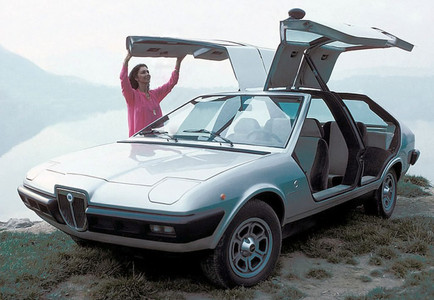Giovanni Michelotti’s seagull, how the Lancia Beta 1800 “Mizar” was born
- Edgardo Michelotti
- Aug 19, 2024
- 5 min read
It is still the only four-door car with gull-wing doors today, and one of the most representative prototypes of the vast production of Giovanni Michelotti, the most prolific Italian designer in the country’s style history. A comfortable yet sporty sedan that easily seats four people, built on the Lancia Beta 1800, débuted at the 1974 Turin Motor Show, arousing great interest and curiosity. Giovanni’s son Edgardo Michelotti, who was personally involved in its creation, tells us about the car in detail. And with this article, he begins his collaboration with SpeedHolics. Words Edgardo Michelotti Photos and drawings Archivio Storico Michelotti (http://www.archiviostoricomichelotti.it/)

“For me, what counts in a car is its style.” My father had clear ideas about design, and the Lancia Beta 1800 Mizar, one of his last creations, is one of the most significant examples of his infinite production.
In the early 1970s, Michelotti had already made his name in the international car world. Like both previous and subsequent projects, this was a fully-fledged part of his research into aerodynamics, passive safety and comfort, thanks also to the availability of specific technologies that didn't exist years earlier.
Dad worked in a new 1800 m2 facility where all the phases of prototype construction were performed, with a 500 m2 engineering and style department and around 25 employees. This is where the Mizar was born, completely in-house. In 1973, I began to work in the coachbuilders as an apprentice aged 22.
I remember my surprise when my father asked me what I thought about producing a four-door gull-wing car for the Turin Motor Show to be held the next year. A stimulating project that was to be a world first, something never built before.
Initially I told him I was flattered that he had asked, but that I wasn't expert enough to express an opinion. But he insisted, as he was interested in the opinion of someone younger (even before I joined, he had probably done a survey among his colleagues). In the end, I said yes, it seemed like a good idea.
My involvement began with a prospect view sketch of the car and a 1:10 scale drawing, which he told me to copy in pencil on tracing paper. It was not an easy task. In the end, he examined my work and complimented me, but one detail on the drawing was not perfect. So I had to draw it all over again, as his way of working didn't allow us to use a rubber. But the second, and then the third and many other copies also had defects. Substantially, I drew the same thing for days and days, accumulating a mountain of almost identical sheets.
After two weeks, I finally managed to produce what he thought was the definitive drawing, having silently and obediently demonstrated my perplexity over his way of doing things.
Pencil drawings of the side view of two alternative versions of the Mizar made in December 1973, when Michelotti was still trying to give the car its definitive style. Two of the drawings made by Edgardo Michelotti following his father’s instructions that would be used to create the 1:1 scale construction plan.
And then we made a heliographic copy and with a few strokes of watercolour he turned the drawing into a masterpiece. He then allowed me to take part in the 1:1 scale design of the construction plan of the car. It was a great time for me professionally, and I still remember it fondly.
Some of the life-sized scale construction of the Mizar with the wooden jig and panel assembly jig, all made in the workshop in Orbassano, just outside Turin. The car was made from iron sheet, following the typical methodology used for making single prototypes. The car was also painted and upholstered at the workshop.
Only a few years later did I realise that his – albeit strange – behaviour had in fact put me to a test, of determination, perseverance, passion and character.
Unfortunetely, I never found out if that first drawing was already acceptable or if the last one still contained errors. What he actually wanted to check was something else.
Considering the period in which it was made, the car was something extraordinary. One of the things it included was also the classic front grille, which the parent company had abandoned years earlier (but returned to in subsequent production models).
At that time, Michelotti collaborated with the Fiat Style Centre, working with Paolo Boano, style manager, and Giuseppe Civardi, in charge of the bodywork. But there was no particular contact between them and my father in the definition of this exclusive model, aside from purchasing the chassis and the mechanics.
Some photos of the finished car taken in April 1974 opposite the entrance to the office building and in the courtyard in Orbassano.
The Mizar was an instant success among the general public and received favourable reviews in the specialist press. The four-seater car had retracting headlights, polyurethane bumpers (previously tested on the prototypes of the 1971 Fiat 128 Coupé Pulsar and the 1972 Fiat 132 Coupé, both presented at the Geneva and Turin motor shows) and extraordinary aerodynamics.

The Michelotti stand set up at the 1974 Turin Motor Show where the Mizar was presented to the public for the first time.
On the final road test, I remember it seemed like flying a glider: not a draught or tiny whistle of air. The visibility was exceptional and the upholstered seats assured comfort even on long journeys.
The gull-wing doors, the other great novelty of this new design, were driven by a large piston mounted on the central steering column, one for each door. The doors opened individually, although to add a touch of the spectacular, in the photos they are always shown both open. This made the construction even more complex, but the end result was way beyond all expectations.
The car was completed in time for its world preview at the Turin International Motor Show in spring 1974, and later also at Geneva and Barcelona the following year.
Unfortunately, due to its design the Mizar could not be type-approved, as the gull-wing doors couldn't open if the car overturned. In the end, it was simply an interesting style exercise, which ended with the production of a working prototype.
Images from the Lancia Beta 1800 Mizar press folder taken at Avigliana Lake, near Turin
The project did however have a happy ending: the Swiss high-end car importer Willy Felber ordered a modification on seven Lancia Beta 1800s, proposing the same front as our Mizar and the rear with the opening rear hatch window. The passenger compartment and doors remained those of the originals.
In 1978 my father sold the car to a Japanese collector who I didn’t have the chance to meet. I believe that it is still being admired in the Far East, although I recently heard (but have not checked) that due to his age and health the owner wants to sell it, but that’s still to be confirmed.
What is certain is that it is the only car ever built with four opening gull-wing doors and the rear hatch window as a fifth door. About tha author Edgardo Michelotti: Born in 1952, I hold a diploma as a surveyor and pursued a degree in Architecture in Turin. I began working alongside my father in 1973 until his illness and passing in early 1980. I continued his work until 1991, when I transitioned away from the automotive industry. For the next 15 years, I focused on industrial design, while also engaging in photography and archival digitization from 2003 to the present. This allowed me to manage an extensive archive, including the specific cataloging and complete digitization of approximately 6,000 graphic units, 20,000 photographs, 7,000 kg of full-scale design plans, as well as scale models, tools, correspondence, and periodicals. The archive spans over three decades, covering the 1950s, 60s, and 70s.











































Comments